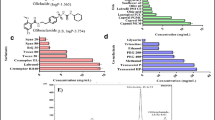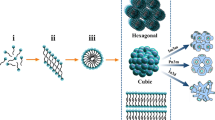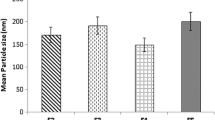Abstract
Reverse hexagonal (H2) liquid crystals formed from selachyl alcohol were demonstrated to sustain the absorption of the poorly water-soluble drug cinnarizine (CZ) after oral administration to rats. When CZ was administered as a bolus lipid solution in selachyl alcohol, the T max was observed to be 23.5 ± 5.9 h, significantly longer than the control suspension (1 h). Administration of selachyl alcohol as dispersed nanoparticles (hexosomes) also resulted in a sustained plasma profile, with drug concentrations maintained from 20 to 40 ng/mL over the first 24 h after administration. Sustained absorption of CZ from the selachyl alcohol hexosomes led to a significant enhancement (p < 0.05) in oral bioavailability (F% = 17%) compared to the control CZ suspension (9%). Analysis of selachyl alcohol hexosomes using small-angle x-ray scattering indicated that neither the presence of CZ (7 mg/g) nor simulated intestinal fluid altered the H2 nanostructure. Selachyl alcohol is not susceptible to digestion. Prolonged absorption from the selachyl alcohol-based H2 systems was attributed to the non-digestible nature of the lipid, similar to non-digestible phytantriol cubic (V2) systems previously reported. Furthermore, the likely presence of non-sink conditions in the gastric compartment provides a drug reservoir requiring gastric emptying to stimulate drug release from the formulation. This study highlights the potential use of non-digestible liquid crystalline systems generally and nanostructured liquid crystalline particles in particular as novel sustained oral drug delivery systems.






Similar content being viewed by others
References
Siekmann B, Bunjes H, Koch M, Westesen K. Preparation and structural investigations of colloidal dispersions prepared from cubic phase monoglyceride/water phases. Int J Pharm. 2002;244(1–2):33–43.
Esposito E, Cortesi R, Drechsler M, Paccamiccio L, Mariani P, Contado C, et al. Cubosome dispersions as delivery systems for percutaneous administration of indomethacin. Pharm Res. 2005;22:2163–73.
Dong Y-D, Larson I, Hanley T, Boyd BJ. Bulk and dispersed aqueous phase behaviour of phytantriol: effect of vitamin E acetate and F127 polymer on liquid crystal nanostructure. Langmuir. 2006;22:9512–8.
Gustafsson J, Nylander T, Almgren M, Ljusberg-Wahren H. Phase behavior and aggregate structure in aqueous mixtures of sodium cholate and glycerol monooleate. J Colloid Interface Sci. 1999;211:326–35.
Andersson S, Jacob M, Ladin S, Larsson K. Structure of the cubosome—a closed lipid bilayer aggregate. Z Kristallogr. 1995;210:315–8.
Landh T. Phase behavior in the system pine needle oil monoglycerides-poloxamer 407-water at 20°C. J Phys Chem. 1994;98(34):8453–67.
Gustafsson J, Ljusberg-Wahren H, Almgren M, Larsson K. Submicron particles of reversed lipid phases in water stabilized by a nonionic amphiphilic polymer. Langmuir. 1997;13:6964–71.
Shah JC, Sadhale Y, Chilukuri DM. Cubic phase gels as drug delivery systems. Adv Drug Delivery Rev. 2001;47(2–3):229–50.
Burrows R, Collett JH, Attwood D. The release of drugs from monoglyceride-water liquid crystalline phases. Int J Pharm. 1994;111(3):283–93.
Drummond CJ, Fong C. Surfactant self-assembly objects as novel drug delivery vehicles. Curr Opin Colloid Interface Sci. 2000;4:449–56.
Leesajakul W, Nakano M, Taniguchi A, Handa T. Interaction of cubosomes with plasma components resulting in the destabilization of cubosomes in plasma. Colloids Surf B Biointerfaces. 2004;34(4):253–8.
Engstrom S, Ericsson B, Landh T, editors. A cubosome formulation for intravenous administration of somatostatin. Proceedings of the International Symposium on Controlled Release of Bioactive Materials; 1996.
Boyd B, Whittaker DV, Khoo S-M, Davey G. Hexosomes formed from glycerate surfactants- formulation as a colloidal carrier for irinotecan. Int J Pharm. 2006;318(318):154–62.
Lopes L, Ferriera D, Paula D, Garcia M, Thomazini J, Fantini M, et al. Reverse hexagonal phase nanodispersion of monoolein and oleic acid for topical delivery of peptides: in vitro and in vivo penetration of cyclospoin A. Pharm Res. 2006;23:1332–42.
Libster D, Aserin A, Wachel E, Shoham G, Garti N. A HII liquid crystal-based delivery system for cyclosporin A: physical characterization. J Colloid Interface Sci. 2007;308:514–24.
Swarnakar N, Jain V, Dubey V, Mishra D, Jain N. Enhanced oromucosal delivery of progesterone via hexosomes. Pharm Res. 2007;24:2223–30.
Esposito E, Carrotta V, Scabbia A, Trombelli L, D’Antona P, Menegatti E, et al. Comparative analysis of tetracycline-containing dental gels: poloxamer- and monoglyceride-based formulations. Int J Pharm. 1996;142:9–23.
Norling T, Lading P, Engstrom S, Larsson K, Krog N, Nissen S. Formulation of a drug delivery system based on a mixture of monoglycerides and triglycerides for use in the treatment of periodontal disease. J Clin Periodontol. 1992;19:687–92.
Shah M, Paradkar A. Cubic liquid crystalline monooleate matrices for oral delivery of enzyme. Int J Pharm. 2005;294:161–71.
Wyatt DM, Dorshel D. A cubic-phase delivery system composed of glyceryl monooleate and water for sustained release of water-soluble drugs. Pharm Tech. 1992;16(10):116–30.
Sallam A-S, Khalil E, Ibrahim H, Freij I. Formulation of oral dosage form utilizing the properties of cubic liquid crystalline phases of glyceryl monooleate. Eur J Pharm Biopharm. 2002;53(3):343–52.
Boyd BJ, Khoo S-M, Whittaker DV, Davey G, Porter CJH. A lipid-based liquid crystalline matrix that provides sustained release and enhanced oral bioavailability for a model poorly water soluble drug in rats. Int J Pharm. 2007;340:52–60.
Fong C, Krodkiewska I, Wells D, Boyd BJ, Booth J, Bhargava S, et al. Submicron dispersions of hexosomes based in novel glycerate surfactants. Aust J Chem. 2005;58:683–7.
Nguyen T, Hanley T, Porter C, Larson I, Boyd B. Phytantriol and glyceryl monooleate cubic liquid crystalline phases as sustained-release oral drug delivery systems for poorly water soluble drugs II. In-vivo evaluation. J Pharm Pharmacol. 2010;62:856–65.
Nguyen T, Hanley T, Porter C, Boyd B. Nanostructured liquid crystalline particles provide long duration sustained-release effect for a poorly water soluble drug after oral administration. J Control Release. 2011;153(2):180–6.
Barauskas J, Johnsson M, Nylander T, Tiberg F. Hexagonal liquid crystalline nanoparticles in aqueous mixtures of glyceryl monooleyl ether and pluronic F127. Chem Lett. 2006;35(8):830–1.
Kossena GA, Charman WN, Boyd BJ, Dunstan DE, Porter CJH. Probing drug solubilization patterns in the gastrointestinal tract after administration of lipid-based delivery systems: a phase diagram approach. J Pharm Sci. 2004;93(2):332–48.
Nguyen T, Hanley T, Porter C, Larson I, Boyd B. Phytantriol and glyceryl monooleate cubic liquid crystalline phases as sustained-release oral drug delivery systems for poorly water soluble drugs I. Phase behaviour in physiologically-relevant media. J Pharm Pharmacol. 2010;62:844–55.
Tilley A, Dong Y-D, Amenitsch H, Rappolt M, Boyd BJ. Transfer of lipid and phase reorganisation in self-assembled liquid crystal nanostructured particles based on phytantriol. Phys Chem Chem Phys. 2011;13(8):3026–32.
Hyde S, editor. Identification of lyotropic liquid crystalline mesophases. Handbook of Applied Surface and Colloid Chemistry. Chichester, UK John Wiley & Sons; 2002.
Kaukonen AM, Boyd BJ, Porter CJH, Charman WN. Drug solubilization behaviour during in vitro digestion of suspension formulations of poorly water- soluble drugs in triglyceride lipids. Pharm Res. 2004;21(2):254–60.
Kaukonen AM, Boyd BJ, Porter CJH, Charman WN. Drug solubilization behaviour during in vitro digestion of simple triglyceride lipid solution formulations. Pharm Res. 2004;21(2):245–53.
Sek L, Porter CJH, Kaukonen A, Charman WN. Evaluation of the in-vitro digestion profiles of long and medium chain glycerides and the phase behaviour of their lipolytic products. J Pharm Pharmacol. 2002;54:29–41.
Krise JP, Charman WN, Charman SA, Stella VJ. A novel prodrug approach for tertiary amines. 3. In vivo evaluation of two N-phosphonooxymethyl prodrugs in rats and dogs. J Pharm Sci. 1999;88(9):928–32.
Kossena GA, Charman WN, Boyd BJ, Porter CJH. A novel cubic phase of medium chain lipid origin for the delivery of poorly water soluble drugs. J Control Release. 2004;99(2):217–29.
Ogiso T, Kasutani M, Tanaka H, Iwaki M, Tanino T. Pharmacokinetics of epinastine and a possible mechanism for the double peaks in oral plasma concentration profiles. Biol Pharm Bull. 2001;24(7):790–4.
Takamatsu N, Welage L, Hayashi Y, Yamamoto R, Barnett JL, Shah VP, et al. Variability in cimetidine absorption and plasma double peaks following oral administration in the fasted state in humans: correlation with antral gastric motility. Eur J Pharm Biopharm. 2002;53:37–47.
Ezzet F, Krishna G, Wexler D, Statkevich P, Kosoglou T, Batra V. A population pharmacokinetic model that describes multiple peaks due to enterohepatic recirculation of ezetimibe. Clin Ther. 2001;23(6):871–85.
Plusquellec Y, Campistron G, Staveris S, Barre J, Jung L, Tillement J, et al. A double-peak phenomenon in the pharmacokinetics of veralipride after oral administration: a double site model for drug absorption. J Pharmacokinet Biopharm. 1987;15(3):225–38.
Lennernas H, Ragardh C. Evidence for an interaction between the β-blocker pafenolol and bile salts in the intestinal lumen of the rat leading to dose-dependent oral absorption and double peaks in the plasma concentration-time profile. Pharm Res. 1993;10(6):879–83.
Carey MC, Small D. The characteristics of mixed micellar solution with particular reference to bile. Am J Med. 1970;49:590–608.
Hofmann A. The behavior and solubility of monoglycerides in dilute, micellar bile-salt solution. Biochemica et Biophysica Acta. 1963;70:306–16.
Bergstrom S, Blomstrand R. The intestinal absorption and metabolism of chimyl alcohol in the rat. Acta Physiologica Scandinavia. 1957;38(2):166–72.
Blomstrand R, Ahrens E. Absorption of chimyl alcohol in man. Proc Soc Exp Biol Med. 1959;100:802–5.
Lee J, Young S, Kellaway IW. Water quantitatively induces the mucoadhesion of liquid crystalline phases of glyceryl monooleate. J Pharm Pharmacol. 2001;53:629–36.
Nielsen LS, Schubert L, Hansen J. Bioadhesive drug delivery systems I. Characterisation of mucoadhesive properties of systems based on glyceryl mono-oleate and glyceryl monolinoleate. Eur J Pharm Sci. 1998;6(3):231–9.
Geraghty P, Attwood D, Collett J, Sharma H, Dandiker Y. An investigation of the parameters influencing the bioadhesive properties of Myverol 18-99/water gels. Biomaterials. 1997;18:63–7.
Gruber P, Rubinstein A, Li V, Bass P, Robinson J. Gastric emptying of nondigestible solids in the fasted dog. J Pharm Sci. 1987;76:117–22.
Boyd BJ. Characterisation of the drug release from cubosomes using the pressure ultrafiltration method. Int J Pharm. 2003;260(2):239–47.
Acknowledgements
The authors thank Nikko Chemicals for the kind donation of selachyl alcohol to these studies. The authors also thank the Australian Institute of Nuclear Science and Engineering for funding of the SAXS studies (grant AINGRA06018). This research was undertaken on the small- and wide-angle scattering beamline at the Australian Synchrotron, VIC, Australia. T-H N. thanks Monash Research Graduate School for financial support.
Author information
Authors and Affiliations
Corresponding author
Rights and permissions
About this article
Cite this article
Nguyen, TH., Hanley, T., Porter, C.J.H. et al. Nanostructured reverse hexagonal liquid crystals sustain plasma concentrations for a poorly water-soluble drug after oral administration. Drug Deliv. and Transl. Res. 1, 429–438 (2011). https://doi.org/10.1007/s13346-011-0045-z
Published:
Issue Date:
DOI: https://doi.org/10.1007/s13346-011-0045-z




